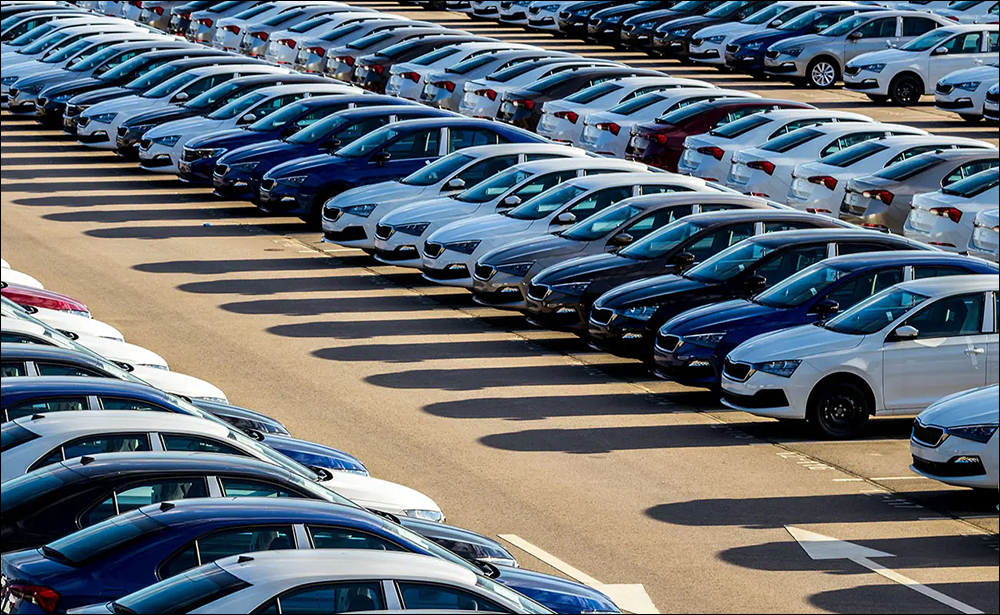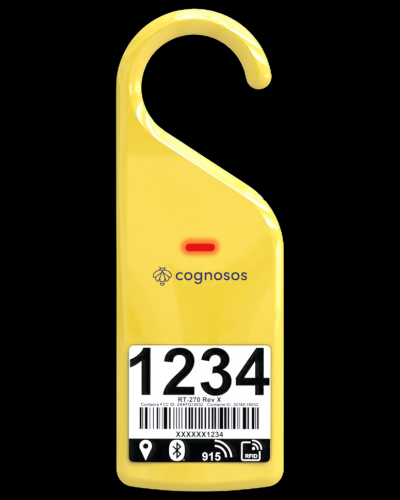RFID Journal LIVE! 2023 will feature end-user companies discussing RFID’s use in various industries, as well as exhibitors offering tagging solutions for multiple applications. To learn more, visit the event’s website.
Real-time location systems (RTLS) company Cognosos has released a new version of its finished vehicle logistics tags that includes Bluetooth Low Energy (BLE) and an LED light to help workers locate vehicles within a yard or lot. The use of BLE technology enables a feature known as SpotLight, by which the vehicle tag lights up to identify itself when so prompted via an app.

The technology helps companies locate and identify vehicles in lots containing thousands of spaces.
The technology, according to Cognosos, is intended to be a low-infrastructure solution that helps companies locate and identify vehicles in lots containing thousands of spaces, without requiring a network of readers or gateways. Instead, a single gateway can send and receive data to and from GPS-enabled tags, while the Bluetooth module in tablets or phones can communicate with tags within range, to help workers uniquely identify the specific vehicle they seek, explains Adrian Jennings, Cognosos’s chief product officer.
The goal, the company indicates, is to help automobile carriers and drivers find the right vehicles within crowded lots. Such workers have traditionally had to walk along parking spaces, or in large yards such as automotive manufacturing sites, visually searching for the finished product that needed, based on the color, make and model. This manual process often required them to read each car’s vehicle identification number (VIN) to ensure they picked the right one.
Cognosos had already been serving this market with an outdoor asset tag designed to provide location data via GPS, transmitted to a server via a 433 MHz active transmission to a dedicated gateway. In that way, companies could view the general area where cars were located, so that drivers could more easily find the vehicles they needed (see RTLS Solution Offers Alternative to Traditional RFID Vehicle Tracking).
How the System Works
At regular intervals, the asset tags transmitted their GPS coordinates and a unique identifier in order to provide an approximate location. They did so via 433 MHz transmission, which requires relatively little power but is a one-way technology. “That was basically the one-way link from the tags back to our gateways, all very simple,” Jennings says. The gateways can receive transmissions from up to several miles away outside, he says, but some companies indicated they wanted even more precise location so that drivers could be sure they were moving the right vehicles.

Users are leveraging the technology not only to find specific cars based on their flashing LED light, but also to identify categories of vehicles.
There are some technology-based options that could make location more granular. For example, ultra-wideband (UWB) or proprietary active RFID systems comprising numerous readers can pinpoint the location of a battery-powered tag in a car, within feet or even centimeters. However, Cognosos sought to provide a less complex and less expensive solution that would not be power-hungry. “We’ve always been a company focused on creating low-cost, low-friction solutions,” Jennings states, “so infrastructure is a four-letter word here.”

The RT-270 tag
The company wanted to build a solution without requiring a large number of gateways, which would be fast and easy to deploy. It also sought to provide a simple visual for drivers, without requiring them to open an app. By building a light into the tag and making it two-way-compatible, Cognosos determined that it could create a product which would respond to prompts with a visual indication, like a student raising a hand at school.
The goal, the company explains, was to make a vehicle identifiable even at night, on a dark day, or when the lot and cars were covered in snow. With that in mind, the RT-270 tag accomplishes a 900 MHz transmission to a gateway in two directions, along with including BLE and a bright LED light. Users might include operators of vans that bring drivers into a lot to collect cars. They would download the SpotLight app, typically on a dedicated ruggedized tablet.
The van operators could input a request to identify the locations of all vehicles that drivers needed to find, then move them to the appointed areas, such as in rail yards or on delivery trucks. The app would leverage the GPS data being collected from the tags and transmitted to the Cognosos server via 900 MHz. The software would display the general location of those vehicles within 20 to 30 feet, and the van operator could then drive to those areas. Upon arriving at a zone in which cars that have been ordered are parked, the driver would select a prompt to spotlight the appropriate vehicles.
The tablet would transmit its Bluetooth signal, which would be received by these specific tags, causing them to turn on their LED light. The driver would step off the van and simply proceed to any cars in which an illuminated tag was visible, then drive those cars to their appointed location, without having to verify VINs. The technology is intended to improve efforts during evening and nighttime work, or on cloudy days when lighting makes it more difficult to identify vehicles.
Hey, Pick Me, Pick Me!
Users are leveraging the technology not only to find specific cars based on their flashing LED light, but also to identify categories of vehicles. For instance, they may want to ship all red cars that came from a specific production run. A user could select all vehicles from the category in the app, and the lights would begin flashing from all of them until they were driven away. “It takes a lot of error out of the process,” Jennings says. The system can be adjusted according to a user’s particular needs. For instance, they can adjust the length of time for which the LED continues to blink before shutting off.

Adrian Jennings
In addition, the system can be configured to flash in different patterns based on a category. Cars that must be delivered to a dealer could flash quickly, while those headed for a maintenance shop could flash slowly. The lights ultimately mean drivers do not have to use their phones, which automotive companies prefer. One manufacturer was the first to beta-test the system earlier this year, with 1,000 SpotLight tags used along with its existing 20,000 tags, which were tested for one month. That company is now in the process of deploying the technology.
In the long term, there are other potential applications for the technology that Cognosos is targeting as well. “We’re just scratching the surface of what we can do with the combination of GPS and Bluetooth,” Jennings says. For instance, trailers and containers can be uniquely challenging to locate and identify in large yards. GPS tags can be limited by the fact that users can easily apply the tags to the top of a trailer, where they would have the most satellite access. “For all kinds of ergonomic reasons,” he adds, “such tags can’t go up high.”
The RT-270 is designed to be lightweight so that it can be easily attached to a vehicle’s rearview mirror, and it offers a long battery life. The company says the solution can be deployed within weeks, minimizing the amount of time before an automotive or fleet company gains a return on its investment. Cognosos also offers its technology for indoor use, for such applications as hospital asset management, using BLE transmissions and with artificial intelligence functionality built into the sensors to analyze and manage the collected data before it is transmitted (see AI, Machine Learning Provide Real-Time Location with BLE).
Key Takeaways:
- By combining GPS and BLE data, Cognosos has built a vehicle identification solution without the high cost of RTLS reading infrastructure.
- GPS finds the general location, then BLE prompts a tag to light up so operators can go to the vehicles they need to move.


